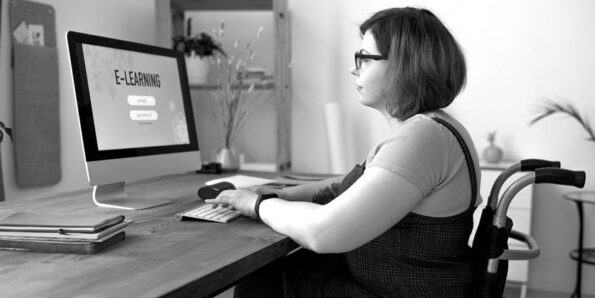If you’re one of the growing number of eLearning professionals who has realised the importance of creating eLearning resources which are accessible for people with disabilities and impairments, you might think it would be easy to find guidance on the standards you need to follow.
What’s wrong with eLearning accessibility ‘tips’?
Yet, if you run a search for eLearning accessibility, you are most likely to find articles with ‘tips’, ‘tricks, ‘key points’, or ‘quick wins’. These types of articles are important for raising awareness in a non-intimidating way, but it’s time for the industry to move beyond accessibility ‘tips’. What eLearning professionals need is a specific set of industry wide standards and guidance on how to achieve them.
What are the drivers for change?
There are two important drivers for this change. The first is the growing global trend to strengthen digital accessibility laws. The second is the move towards W3C’s Web Content Accessibility Guidelines (WCAG) as the legal standard. The recent EU Directive on the accessibility of websites and mobile applications, demonstrates both these trends. In September 2018 this directive became law in all member states including the UK (and will remain regardless of Brexit) where it is known as the Public Sector Bodies (Websites and Mobile Applications) Accessibility Regulations. Although the legislation currently only applies to the public sector, it now provides the benchmark for eLearning accessibility.
What do eLearning professionals need?
Instead of ‘7 tips for designing accessible eLearning’, what eLearning professionals now need is, ‘How to meet the 50 A and AA WCAG 2.1 success criteria when creating accessible eLearning.’ But how is it possible to achieve this in an article or a blog? I have consolidated the information I use when delivering training into the table below to show one way it can be done. This shows some of the strategies which work well when trying to simplify eLearning accessibility and engage people with something that often seems abstract and complicated.
At a glance guide to creating accessible eLearning
| Vision | Hearing | Mobility | Cognitive | |
|---|---|---|---|---|
| Permanent impairment (20% of the UK population & 11% of the UK working population) | Blindness or low vision | Deafness | Parkinson’s | Dyslexia |
| Temporary impairment (Can affect any of us at any time) | Eye laser surgery | Tinnitus | Repetitive Strain Injury | Stress or anxiety |
| Situational impairment (Can affect any of us at any time) | Forgotten reading glasses | No headphones on public transport | Broken mouse | Noisy and distracting working environment |
| 1 way to address this | Ability to enlarge text by at least 200% | Captions on videos | Keyboard accessible content | Clear and consistent navigation |
| How to achieve this in eLearning | Check the publishing options of your authoring tool and that the published output can be enlarged by at least 200%. | Add captions to all videos, either with your authoring tool, or with the captioning facilities available in the sites where embedded videos are held. | Make sure that all mouse only interactivity is replaced with accessible alternatives, e.g. replace drag and drop matching interactions with drop down matching interactions. | Make sure that the navigation items such as the home, forward and back buttons etc. are always in the same place, and in the same order in your resource even if you add new items. |
| Corresponding Web Content Accessibility Guideline (50 A and AA success criteria to meet for legal compliance.) | WCAG 1.4.4 Resize text AA | WCAG 1.2.2 Captions (Prerecorded) A | WCAG 2.1.1 Keyboard A | WCAG 3.2.3 Consistent Navigation AA |
How can this approach help?
- Defining the different types of impairments, allows people to learn more about disability and avoid the assumption that accessibility is just for those who have visual impairments.
- Giving examples of disabilities, allows people to empathise with learners who have accessibility requirements.
- Emphasising how many people have permanent impairments, and introducing the concepts of temporary and situational impairments, allows people to understand how inclusive design can improve the learning experience for everyone.
- Giving practical examples in plain English, which are tailored specifically to creating eLearning using authoring tools, allows people to understand what they need to do and why they need to do it.
- Linking instructions to the Web Content Accessibility Guidelines, allows people to be confident that they are following the required legal standards.
Although the table shows only a very small selection of WCAG success criteria, I hope you agree that it’s a much needed improvement on the accessibility ‘tips’ format which has been popular in the eLearning industry for too long.




Recent Comments